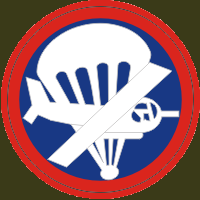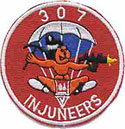|
|
.
307TH
AEB .
|
|
The
307th Engineer Battalion was created August 5, 1917 at
Fort
Gordon,
Georgia.
It was attached to the 82nd Infantry
Division.
During the War, the battalion
participated in the first U.S. offensive
War at St. Mihiel. Later, he participated
in campaigns
of
Lorraine
and Meuse-Argonne. It is during these battles that the 307th
earned the nickname "I Maintain the Right" because it
protected the right flank of the 82nd pushing German
attacks, however superior in numbers.
After the war, the 307th was placed as a
unit Reserve
at
Fort Dix,
New Jersey,
May 17, 1919.
On
March 25,
1942, the battalion was reactivated at
Camp Claiborne,
Louisiana
as part
of the 82nd Division.
Later, August 15, the battalion was re-appointed
as the 307th Airborne Engineer Battalion belonging to the
82nd Airborne Division.
The 307th AEB consist initially of a
company medical,
two engineer companies, the B and C.
A company will be created after the Battle of
Normandy to support the 508th PIR until the end of the war.
Another company will also be created to support
the 325th
GIR.
On
April 29,
1943, the unit shipped to
New York
for a journey
that will lead to
Germany.
![]() Sicily Italy July 43 Operation Husky
Sicily Italy July 43 Operation Husky
The
505th RCT with the 505th PIR, the 456th PFAB and B Company
307th AEB jumped over
Sicily
July 10 is the operation HUSKY I. On 11 July a group of engineers would be sent
on line Biazza.
But they too were parachuted behind enemy lines.
After days of hard fighting, Patton decided to
reinforce its center with more than 2,000 paratroopers of the 504th PIR,
376th PFAB and C Company, 307th AEB. They are grouped under the
504th RCT is Operation HUSKY II.
The drop was scheduled for the night of July 11 near Gela. Throughout the day, German activity was very intense, anti-aircraft gunners were on the nerves. The officers of the Navy and Army have yet been keen to prevent anyone from crossing C-47. But despite that, they opened fire on the aircraft. It was devastating, 37 of 144 aircraft were destroyed, 23 were affected. The airborne forces have had 10% casualties.
![]() Salerno Italy September 43
Operation Avalanche
Salerno Italy September 43
Operation Avalanche
At 3:30,
September 9, 1943, the amphibious operation at
Salerno
began conducting.
The bridgehead was extensive when there came
against the German attack September 12.
The situation was so critical that General
Mark Clark ordered the 82nd to jump directly to the bridgehead.
To guide the pilots of C-47, the men set fire to
sand soaked with gasoline while the towering 45 meters. On the night of
September 13, 1300 the 504th PIR paratroopers and two platoons of C
Company, 307th AEB were dropped over the DZ, which was about 10km south
of 7km Sele near Salerno.
At the sight of corollas parachutes, morale went up. During the following night, the 505th PIR and the B Company 307th AEB made the same jump. At the same time, the first platoon of the 307th jumped with the 509th PIR near Avellino. The 504th (without the 3rd Battalion) took the heights of Altavilla meanwhile, attacked the enemy against the side of the 6th Corps. His commanding officer suggested to withdraw. Summed up the mood of the Regiment, Colonel Tucker to vigorously responded: "Retreat, Hell! - Send me my other battalion!" Thus the 3rd battalion joined the 504th, the enemy was repulsed, and the bridgehead of Salerno, saved.
![]() Anzio Italy January 44 - Operation
Shingle
Anzio Italy January 44 - Operation
Shingle
To
outflank the German defenses along the Gustav Line, an amphibious
invasion was planned. Was assigned to the invasion force, the 504th RCT.
Until 4 January 44, when the 504th RCT was
removed from the front for the preparation of Operation Shingle, he served as
infantry in the advance on Rome.
The 504th RCT was ordered to take the town
of
Borgo
Piave
January 24. Although the city is taken, the men had to withdraw because of the
German artillery. They then held a defensive line along the Mussolini Canal
until we replacements January 28. Then, the 504th PIR was assigned to the
1st Armored Division, while the rest of RCT was assigned to the 3rd
Infantry Division.
The 3rd Battalion, 504th PIR seen its
worst fighting. Because of this action, they became the first American parachute
unit to receive a Presidential Citation. (The equivalent for the unity of the
Medal of Honor to a soldier)
Joined by the 3rd Battalion decimated the
504th RCT was back on its defensive positions on the right flank where they
made aggressive patrols, infiltration through the enemy lines.
This resulted in completely demoralized the
Germans. To demonstrate the remark of a German officer who referred to them by
the nicknamed "Devils in Baggy Pants" nickname for the 504th PIR brought
up to date.
It was assumed that the 504th RCT also
involved in Operation Neptune, but it seemed obvious that the lack of staff
prevented the regiment to participate in the invasion of
Normandy.
Only a dozen men
participate as a pathfinders.
![]() D-DAY
June 44 Normandy France Operation Neptune
D-DAY
June 44 Normandy France Operation Neptune
For
Operation Neptune, the 307th AEB was divided into two companies. The Co B
remained with the 505th, the D will be assigned to the 508th.
On the night of June 5-6, C-47 carrying the
505th RCT took off from
England.
The clouds overhanging the Channel prevented good visibility. When they
finally entered the
Cherbourg
Peninsula,
they were victims of German flak. This had the effect of dispersing devices. It
was 3:00 am when the first para of the 505th RCT jumped from his
aircraft. Many Pathfinders could bring the DZ but many lacked the equipment and
men of the 505th RCT began to land in a large area in the
Normandy
campaign.
For their bravery, their courage during the
invasion, the 307th AEB received a Presidential Citation.
 Holland
September 1944 operation Market-Garden
Holland
September 1944 operation Market-Garden
On
September 9, 1944, The British Field Marshal
Montgomery
proposed a plan called Market Garden was intended to set a bridgehead to the
Rhine
River.
The operation was a combination of an airborne
assault to take and hold key bridges and roads of
Holland
and a feed motor.
For the first time, the 307th AEB would be
dropped as a full battalion.
The mission of the 82nd Airborne was to
capture and secure the bridges over the
Maas
and
Waal
rivers
and the Maas-Waal Canal.
The operation began September 17. The 504th
RCT quickly fixed the first bridge, the largest flying over the river
Maas
hitting both ends simultaneously.
On 20 September the 3rd Battalion, 504th PIR,
commanded by Major Julian Cook with the C Company 307th AEB was
ordered by General Gavin to cross the river and take another important
bridge.
With the support of artillery, the first wave
aboard assault boats crossed the channel. They will lose 200 men. On the other
hand, men of engineering disarm traps laid by the Germans. The commander of
Company C, Captain Wesley D Harris was awarded the DSC for his role in
the crossing of the
Waal.
Finally, at D-Day 4, the 504th RCT took
the bridge, defending against attacks against the German.
However, its success would be short-lived because
the defeat of the Allied troops at
Arnhem.
The move to
Germany
would not open in September 1944 and the 82nd was sent to
France.
![]() Belgium
December 1944 Battle of the Bulge
Belgium
December 1944 Battle of the Bulge
On
December 16, 1944, the Germans launched an offensive through the Belgium
Ardennes surprising the Allies.
Two days later the 82nd was sent to
Werbomont to block the German advance.
On 19 December morning, the 82nd came in
Belgium
and was heading north while the 101st was sent to
Bastogne.
The German advance separated the two airborne
units.
The 82nd has generally faces great
difficulty in taking positions along the north edge of the salient.
The 504th's face particularly heavy German
attacks, thereby winning their second Presidential Citation.
Advancing deep into the heart of Germany, the 504th RCT finally arrived along the western banks of the Rhine River. On April 6, 1945, a company of the 504th PIR with the C Company of 307th AEB crossed the Rhine River near the village of Hitdorf. It served as a decoy to fool the Germans of the true cross. The heavy fighting that ensued did win a presidential citation to the unit.
![]() War over 1945
War over 1945
The war
was officially ended in Europe May 5, 1945.
The 82nd was invited to serve as
occupation forces in the American sector of
Berlin.
There it gained the name of honor guard.
On
January
3, 1946, the 82nd was sent to the United States. They marched in the
Victory Parade in
New York
along
5th
Avenue.
The 307th AEB was the first airborne engineer battalion to participate in 6 combat jumps and 8 campaigns during the Second World War. In 1948, the 307th AEB was withdrawn from the Organized Reserve Corps to be divided into the regular army. In 1957, the unit was reorganized and re-designated 307th Engineer Battalion. C Company was decorated for his service in Vietnam for the period 1968-69.
![]() Awards & Decorations
Awards & Decorations
United States:
Presidential Unit Citation awarded to Company A for its action in Normandy.
Presidential Unit Citation awarded to Company B for its action in Normandy.
Presidential Unit Citation awarded to Company B for its action in Holland.
Presidential Unit Citation awarded to Company C for its action in Holland.
France:
Croix de guerre with palm awarded to A Company for its action in Ste Mere Eglise and Cotentin.
Fourragere awarded to A Company.
Croix de guerre with palm awarded to B Company for its action in Ste Mere Eglise and Cotentin.
Fourragθre awarded to B Company.
Holland:
William Military Order (Rank of Knight and 4th Class) for its action in Nijmegen in 1944.
Lanyard Oranje from the Netherlands for the operation Market Garden
Belgium:
Fourragere for this action in Ardennes.
- Citation of the days order of the Belgian army for its actions in the
Ardennes.
- Citation of the days
order of the Belgian army for its actions in
Belgium and Germany.

